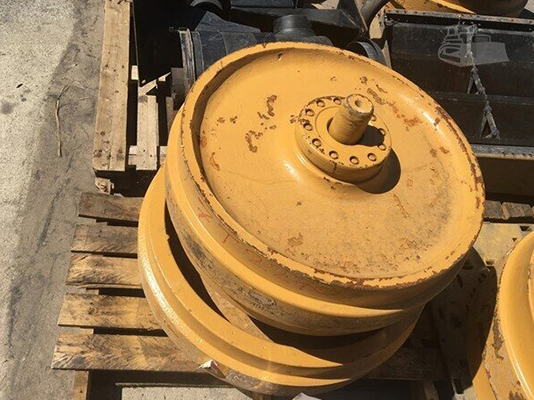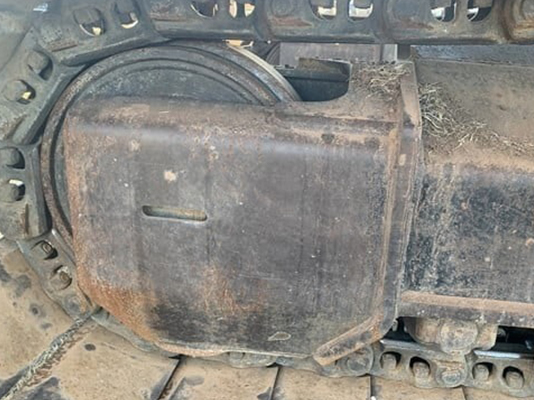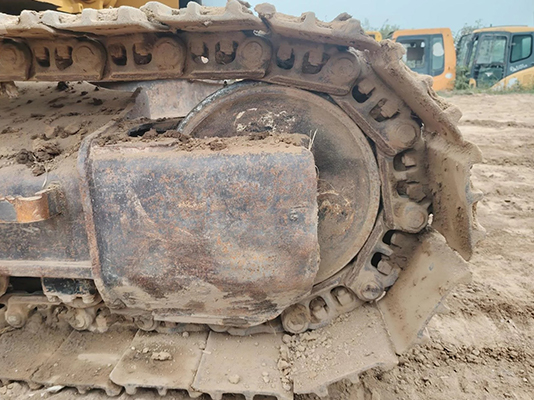How should you maintain and care for your excavator's undercarriage?
Learn how to maintain and care for your excavator's undercarriage to avoid costly damage from worn idlers. Kyotechs experts share essential tips to extend equipment life and prevent breakdowns—start protecting your investment today!
- How Idlers Support Track System Performance
- 1. Tension Regulation: The Backbone of Track Stability
- 2. Weight Distribution: Protecting Undercarriage Components
- 3. Guiding Track Movement: Precision in Motion
- 4. Vibration Dampening: Reducing Stress on the Entire Machine
- Common Signs of Idler Wear
- 1. Visible Physical Damage
- 2. Uneven Track Wear
- 3. Increased Vibration or Noise
- 4. Track Tension Issues
- 5. Reduced Machine Performance
- Choose the right idler to avoid downtime
In heavy machinery—from excavators and bulldozers to track loaders—the undercarriage is the unsung hero that keeps operations moving. Yet among its critical components, idlers often fly under the radar, overshadowed by more visible parts like tracks or sprockets. This oversight is costly: worn idlers don’t just fail on their own—they trigger a domino effect of damage across the entire undercarriage, leading to skyrocketing repair bills, unplanned downtime, and reduced productivity. Let’s break down why idlers matter, how to spot their decline, and how to halt the damage before it’s too late.
How Idlers Support Track System Performance

Idlers are the quiet workhorses of a track system, designed to maintain tension, guide movement, and distribute weight—all while enduring extreme stress. Their role is foundational to the undercarriage’s health, and understanding their function reveals why wear can be so destructive.
1. Tension Regulation: The Backbone of Track Stability
Tracks rely on precise tension to function. Too loose, and they can derail; too tight, and excessive friction wears down components like rollers, pins, and bushings. Idlers act as tensioners, working in tandem with hydraulic systems or springs to keep tracks at optimal tightness. By absorbing shocks from uneven terrain—think rocks, ruts, or debris—they prevent sudden spikes in tension that would otherwise snap links or bend rails. Without properly functioning idlers, tracks become unpredictable: a loose track might slip off during a turn, while an over-tightened one could burn through drive motor belts or strain the sprocket.
2. Weight Distribution: Protecting Undercarriage Components
Heavy machinery carries massive loads, whether it’s a full bucket of gravel or the machine’s own weight. Idlers spread this weight evenly across the track frame and rollers, preventing concentrated pressure that would crack or deform metal parts. For example, when a bulldozer pushes a pile of dirt, idlers bear a portion of the forward force, ensuring the load isn’t dumped entirely on the drive sprocket or track links. This distribution is especially critical on soft ground, where uneven weight can cause the undercarriage to sink, leading to uneven wear on rollers and premature track stretching.
3. Guiding Track Movement: Precision in Motion
Tracks don’t just move forward—they pivot, reverse, and navigate tight spaces. Idlers keep tracks aligned with the sprocket and roller path, preventing lateral slippage that would grind against the track frame or wear down the edges of track links. Imagine a car’s steering wheel: without it, the vehicle drifts off course. Similarly, idlers “steer” the track, ensuring each link engages smoothly with the sprocket’s teeth and glides over rollers without binding. Misaligned idlers (a common result of wear) force tracks to rub against the frame, creating metal-on-metal friction that generates heat and accelerates wear on both the track and the frame itself.
4. Vibration Dampening: Reducing Stress on the Entire Machine
Heavy machinery operates in rough conditions, and every bump or jolt sends vibrations through the undercarriage. Idlers act as shock absorbers, cushioning these impacts to protect sensitive components like hydraulic lines, bearings, and even the machine’s cab. Worn idlers lose this ability: a cracked or misshapen idler can’t absorb vibrations, allowing them to travel up the track frame into the main body of the machine. Over time, this leads to loosened bolts, cracked welds, and even damage to the engine or hydraulic system—issues far more expensive to fix than replacing an idler.
Common Signs of Idler Wear

Idler wear is rarely sudden; it’s a gradual process that leaves clear clues. Catching these signs early can save you from catastrophic undercarriage failure. Here’s what to watch for:
1. Visible Physical Damage
The most obvious red flag is visible wear on the idler itself. Check for:
Grooves or Scoring: As idlers rub against tracks or debris, their outer surface (the “tread”) develops deep, irregular grooves. These grooves mean the idler is no longer rolling smoothly; instead, it’s dragging against the track, increasing friction and heat.
Cracks or Chips: Impact from rocks or heavy loads can cause idlers to crack, especially around the hub (where the idler attaches to the track frame). Even small cracks will spread over time, eventually causing the idler to split apart during operation.
Bent or Warped Frames: Idlers are mounted on brackets or arms that can bend under excessive stress. A bent mount tilts the idler out of alignment, forcing tracks to rub against the frame or sprocket at an angle.
2. Uneven Track Wear
Worn idlers disrupt the track’s natural movement, leading to telltale patterns on the track links or rails:
Edge Wear: If tracks show excessive wear on one edge (more than the other), it’s often due to a misaligned idler. The idler is pulling the track to one side, causing the edge to grind against the frame or sprocket.
Link Stretching: When idlers fail to maintain proper tension, tracks stretch unevenly. You’ll notice gaps between links or “loose” sections that sag when the machine is parked. Stretched tracks are prone to derailment and put extra strain on the drive sprocket, which must work harder to engage stretched links.
Flat Spots on Rollers: Rollers are designed to rotate smoothly, but if idlers are misaligned, rollers bear uneven pressure. This causes flat spots on roller surfaces, which in turn create a bumpy ride that accelerates idler wear—a vicious cycle.
3. Increased Vibration or Noise
A healthy undercarriage operates with a steady, low hum. Worn idlers change that:
Rattling or Clanging: Loose or misaligned idlers vibrate against the track frame, creating a loud, irregular noise. This is often most noticeable when the machine is moving slowly over rough ground.
Shaking in the Cab: As idlers lose their shock-absorbing ability, vibrations travel up to the cab. Operators may feel a persistent shake, especially during turns or when traversing bumps. This isn’t just uncomfortable—it’s a sign that the undercarriage is taking excessive stress.
4. Track Tension Issues
If you’re constantly adjusting track tension—tightening it one day, loosening it the next—idlers are likely to blame. Worn idlers can’t maintain consistent tension: a seized idler (one that won’t rotate) will cause the track to loosen as friction wears away at links, while a bent idler may create uneven tension that makes the track feel “tight” on one side and “loose” on the other. Keep an eye on tension gauges or use the “下垂测试” (sag test): lift the track slightly and measure the gap between the track and the bottom roller. A gap that’s too large (loose) or too small (tight) points to idler problems.
5. Reduced Machine Performance
Worn idlers sap power and efficiency:
Sluggish Movement: A seized or dragging idler increases resistance, forcing the engine to work harder to move the machine. You’ll notice slower acceleration or a drop in productivity—for example, a loader taking longer to haul material.
Poor Maneuverability: Misaligned idlers make turns harder, as tracks may bind or slip. Operators may struggle to keep the machine on course, increasing the risk of accidents or damage to surrounding structures.
Increased Fuel Consumption: When the engine works overtime to overcome idler resistance, fuel usage spikes. Over weeks or months, this adds up to significant costs—often far exceeding the price of a new idler.
Choose the right idler to avoid downtime

An idler may seem like a small part of your machine, but it carries a heavy responsibility. Idler failure can have a ripple effect, damaging the track chain, rollers, and final drive components. Using the right replacement idler prevents wear, helps maintain machine alignment, and prevents costly and avoidable failures.
Need help selecting the right idler? Our team can match you with the parts you need to keep your machine running efficiently. With fast shipping and expert support, we make it easy to get back on track.
If you're interested or have a problem with your excavator, please contact us.

What are some maintenance tips for excavator cabs?

What are the solutions for excavator steering failures?

What causes plunger pump failures? What do plunger pumps work?

What is the reason why the excavator hydraulic pump makes abnormal noise?
FAQS
What parts you have?
We are specialized in excavator spare parts, such as travel motor gearbox assy & parts, swing gearbox motor assy & parts, and hydraulic pump motor assy and spare parts. If any are needed, we can also supply them as per your requirements.
Do you only sell or repair?
Yes, we sell parts and have a repair team to offer support.
1. Software solution.
A. ECU & Monitor Reprogram
B. DPF Program Solution
C. Software refit
2. Engine Rebuild & Testing
Maintenance Team Support
A. ET for Caterpillar Diagnosis
B. Inline 6 for Cummins/Komatsu/Hyundai Diagnosis
C. IDSS for Hitachi/Isuzu/Case/Sany/Sumitomo/JCB/XCMG/Isuzu Truck Diagnosis
D. DX2/NEXIQ for Kobelco/Hino truck Diagnosis
E. Vocom for Volvo/Volvo truck/Penta Diagnosis
F. DST-i for KUBOTA DENSO Diagnosis
3. hydraulic Remanufacture & Testing
A. Offer new or rebuilt hydraulic pump & motor
B. Control valve & main pump repair & rebuild knowledge
C. Offer stable and cheap hydraulic test machines
D. All rebuild valves, pumps, and motors offer testing video for cilent
If i don'thave part number, can you check for me?
Yes, excavator model, old photos, and size are also available to confirm the correct parts you need.
Which shipping term you can supply?
By sea, air or by express ( DHL, Fedex, TNT, UPS, EMS)
How long does it take to my address?

Excavator Spare Parts 4M50 Engine Assembly For Sany SY215

Excavator parts 708-2J-00030 Hydraulic Main Pump For Komatsu PC500LC-10R

Excavator Spare Parts YB60001906 Travel Gearbox For Hitachi EX1200-7 EX1200-6

Excavator parts 21P-60-K1502 Hydraulic Main Pump For Komatsu PC150LC-6K

Excavator Spare Parts 515-0070 Travel Gearbox For Caterpillar E330D2

Excavator Spare Parts 480-6768 Travel Gearbox For Caterpillar E320D2

Excavator Spare Parts 353-0562 Travel Gearbox For Caterpillar E336D



Kyotechs
Kyotechs GZ
Kyotechs
Kyotechs